Solar Panel Bali & Lombok Complete Guide
This Solar Panel Bali & Lombok Guide is created for anyone in Bali and Lombok who are looking to install a solar system.
Whether you own a home, villa, resort, or a different type of business you will benefit from this guide.
We will cover everything you need to know before purchasing solar panels in Bali or Lombok from how it works, how to design and pick the best system, how much does a system cost, and more.
Introduction to solar panels in Bali & Lombok
How solar panels work
Let’s start from the beginning.
The way a solar panel works is quite simple. Solar panels consist of many smaller cells, called photovoltaic cells. Your solar panels capture photons, particles of light from the sun, which are in turn transformed into DC (direct current) electricity.
SOLAR SYSTEM IN A NUTSHELL
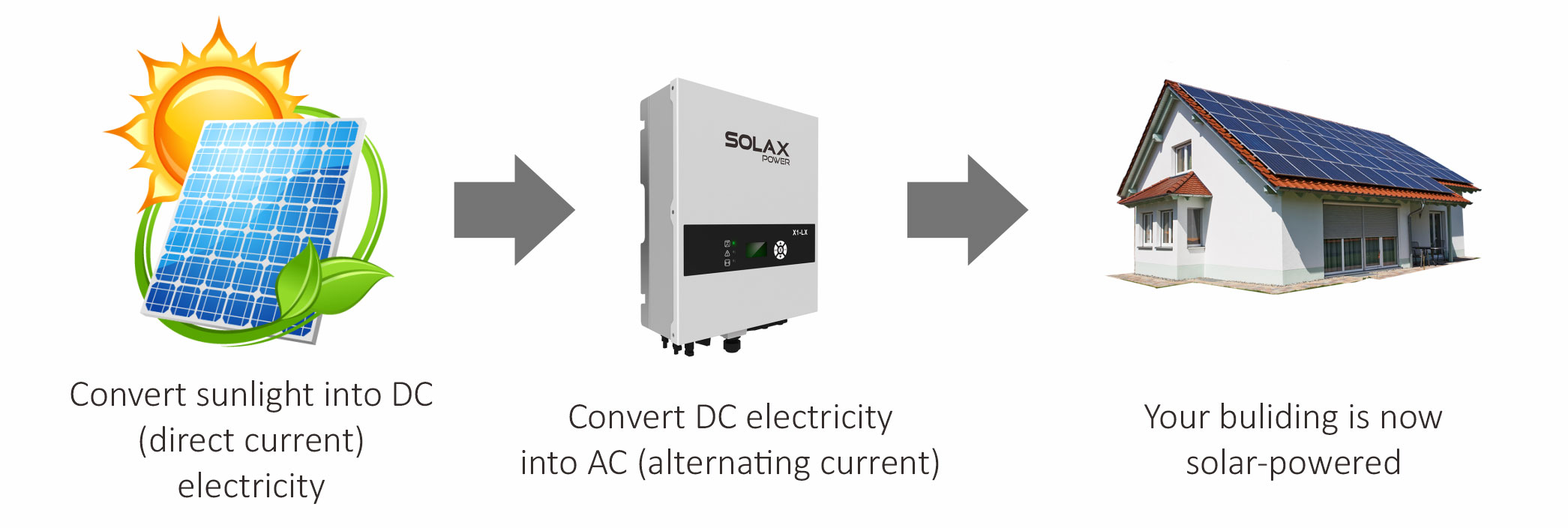
This is where solar inverters come into play and convert DC electricity into AC (alternating current) as most appliances use AC.
In short, a solar system typically consists of 3 to 4 main elements: solar panels, an inverter (or several), a net meter (if you’re connected to the grid), and/or batteries (for hybrid and off-grid solar systems, which will be covered below).
Solar panel output in Bali & Lombok
By using solar panels in Bali, Lombok, and the islands east Indonesia you will benefit from a great sun exposure year-round, with some areas better than others. On average, 1kW of solar PV (photovoltaic) system in lombok produces 4.2 kW-hours worth of electricity per day, year-round on average.
Coastal areas like Bukit and South Lombok, as well as the islands such as Lembongan or the Gilis, generally have more sunshine and higher PV output, while areas higher up the mountainsides, like Ubud, will have less due to more cloud cover.
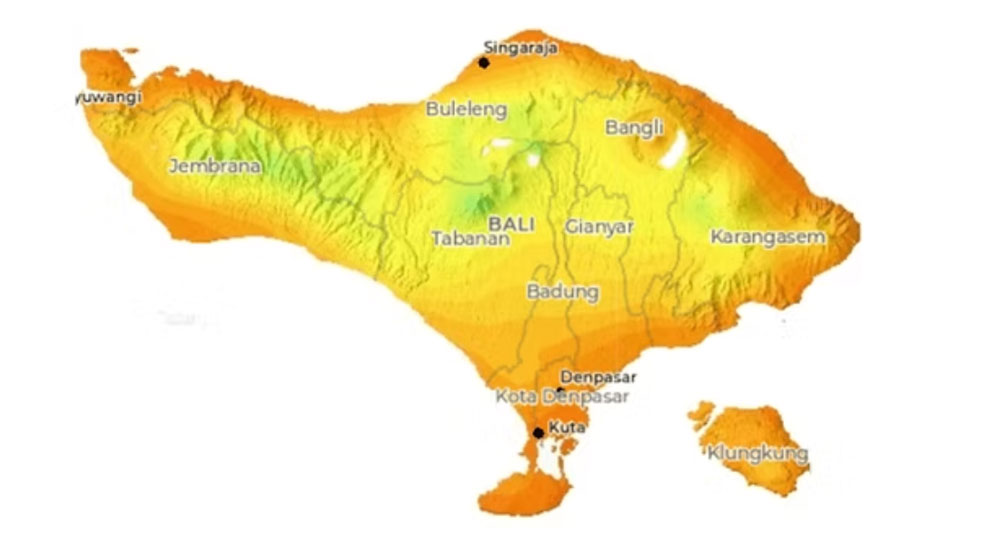
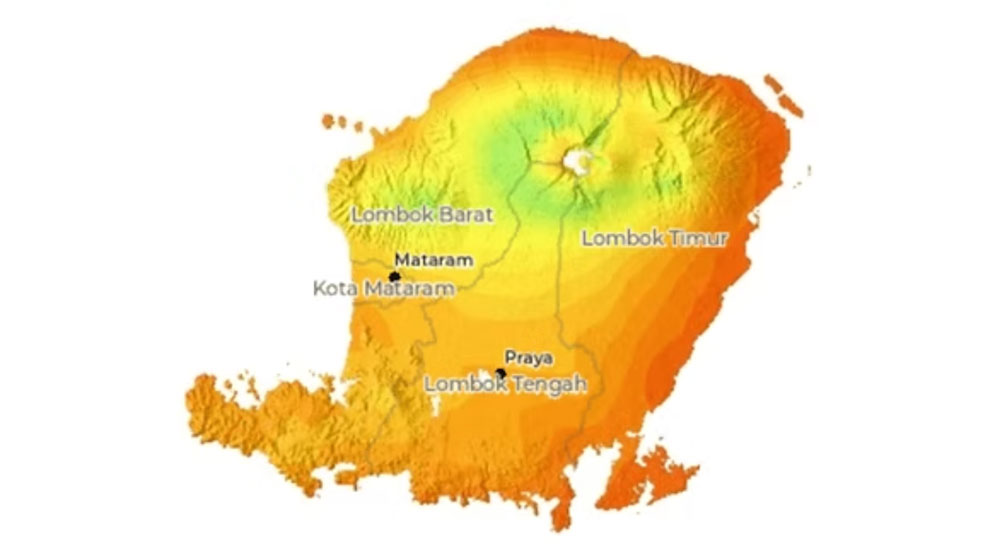
Solar power in cloudy days and night time
Be it in Bali, Lombok or other areas, solar panels will still generate some electricity even when it’s cloudy or raining, but significantly less-up to 90% less in heavy cloud cover.
It is important to note that solar panels do not store any electricity. That is what batteries do and you can opt to add them to your system. As such, a standard solar system without batteries will not generate any electricity at night. We will explore this further in Part III: Types of Solar Systems.
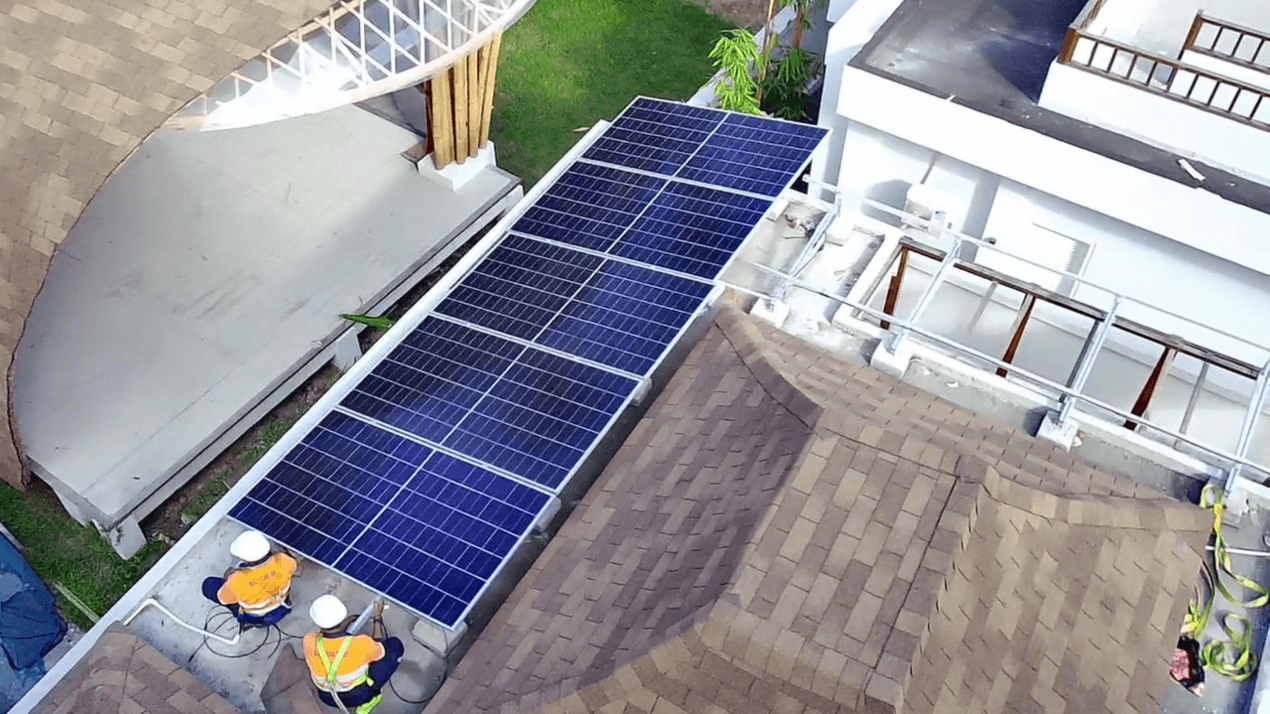
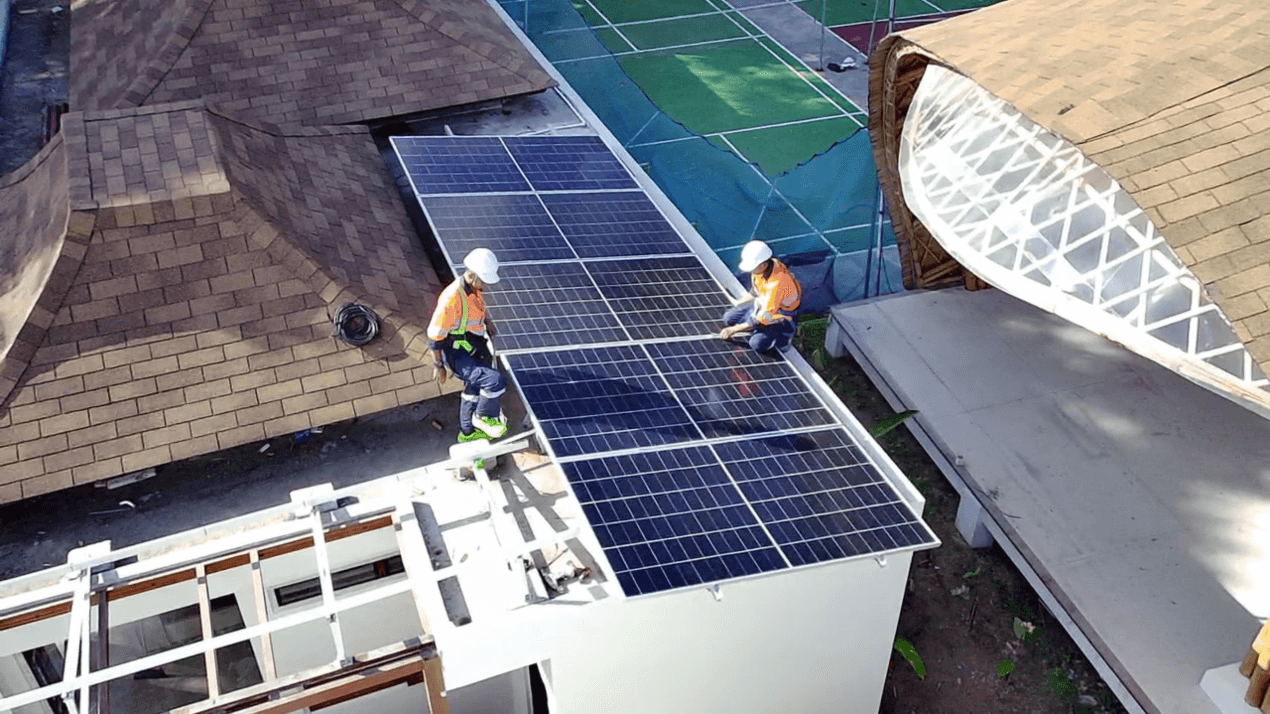
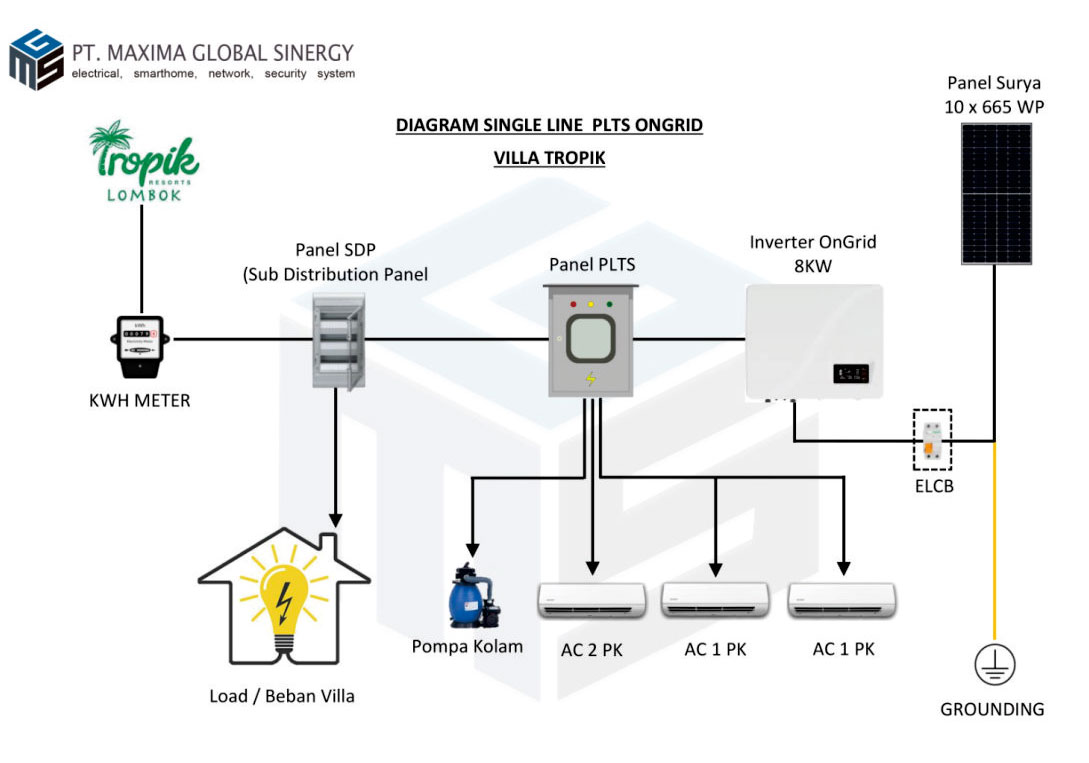
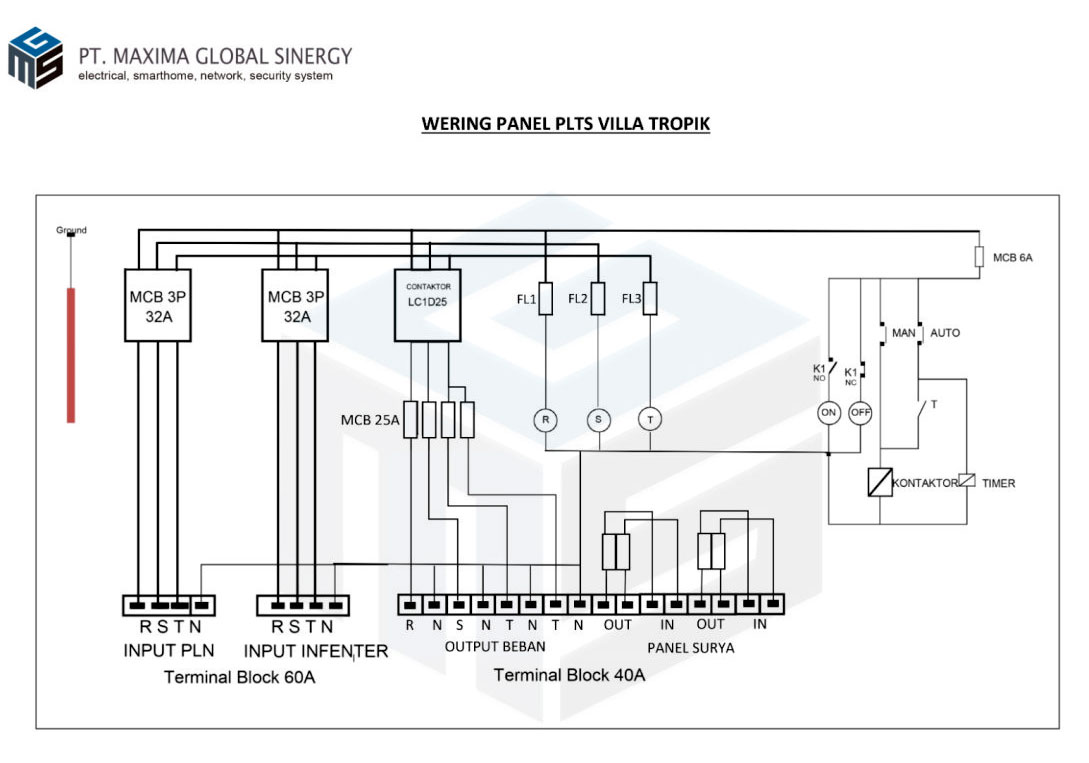
Total Power of Villa Tropik: 16,500 VA
Load Requirements for AC and Pump using the Solar Power System (PLTS):
AC 1 HP, 2 units: 1,600 watts AC 2 HP, 1 unit: 1,600 watts
• Pool pump 1.5 HP: 2,100 watts
Total Load: 5,300 watts
Solar Power System (PLTS) Capacity:
665 Wp x 10 panels = 6,650 watts
The energy generated from sunlight is 6,650 watts, while the load from the AC units and pump is 5,300 watts.
6,650-5,300 = 1,350 watts
The surplus energy generated from the solar power system during peak sunlight is 1,350 watts. This excess energy can support other electrical loads.
Apart from the fact that Bali and Lombok offer a massive solar PV potential, there are a few main reasons for going solar:
1. Reduce CO2 emissions
Solar energy is one of the most affordable and accessible clean and sustainable energy sources there is.
Indonesia depends mainly on fossil fuel-based energy, especially coal, which emits a lot of CO2 and other nasty and toxic fumes. The government is slowly planning to build more solar farms in Indonesia, but installing solar systems at your place of business or home could really speed up the process of switching to a greener and more sustainable source of energy.
2. Save on monthly electricity bill
By having a properly-sized grid-tied solar system, you can expect a monthly electricity bill reduction of over 90%.
When your solar panels are producing electricity during the day, your electricity is practically free, and the surplus of electricity produced by your panels will automatically stored in your battery system for later consumption.
If you chose a system without batteries, surplus is lost, as it cannot be fed into the PLN grid anymore (since May 2024) by law. So batteries may well be worth considering.
3. Provide electricity in remote areas or areas with unreliable electricity supply
PLN is quite reliable in Bali, but there are certain areas where the connection can be patchy and rather expensive to install such as in Lembongan.
Lombok, on the other hand, experiences quite a lot of power outages.
Since your solar system gets switched off by PLN during a blackout for safety reasons, you can opt for a hybrid solar system to solve this issue.
This system pairs your solar panels with backup storage batteries that will supply electricity during outages.
As for completely remote off-the-grid areas outside Bali and Lombok, such as Sumba and many other islands in Indonesia, using solar energy and batteries just makes a lot of sense.
A solar system with lithium batteries will provide clean energy that is more affordable per kWh than a fuel-derived generator that can cost IDR 5,000-10,000 per kWh to fuel.
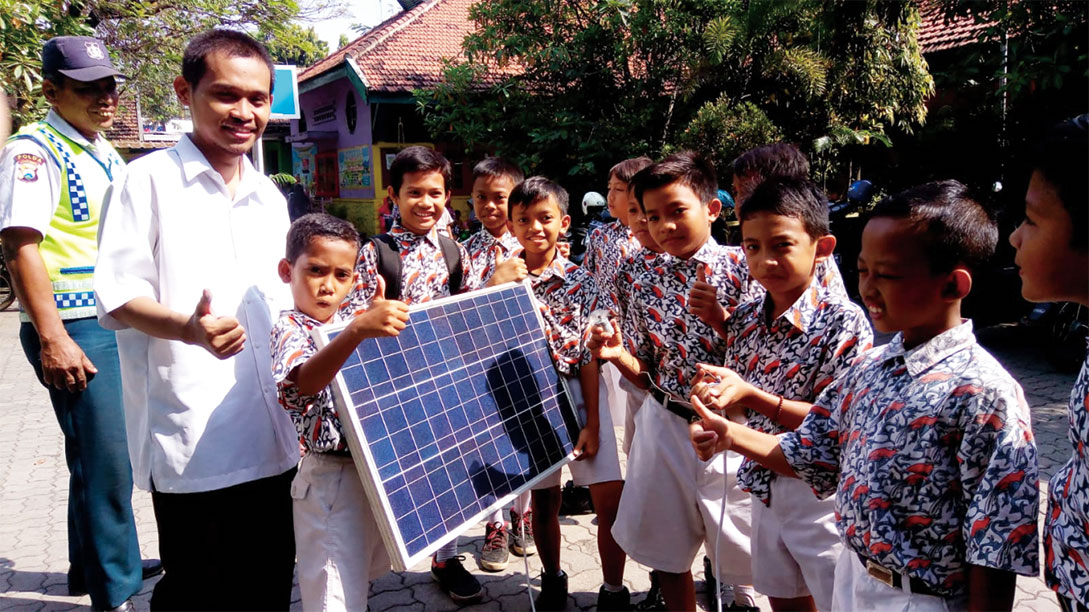
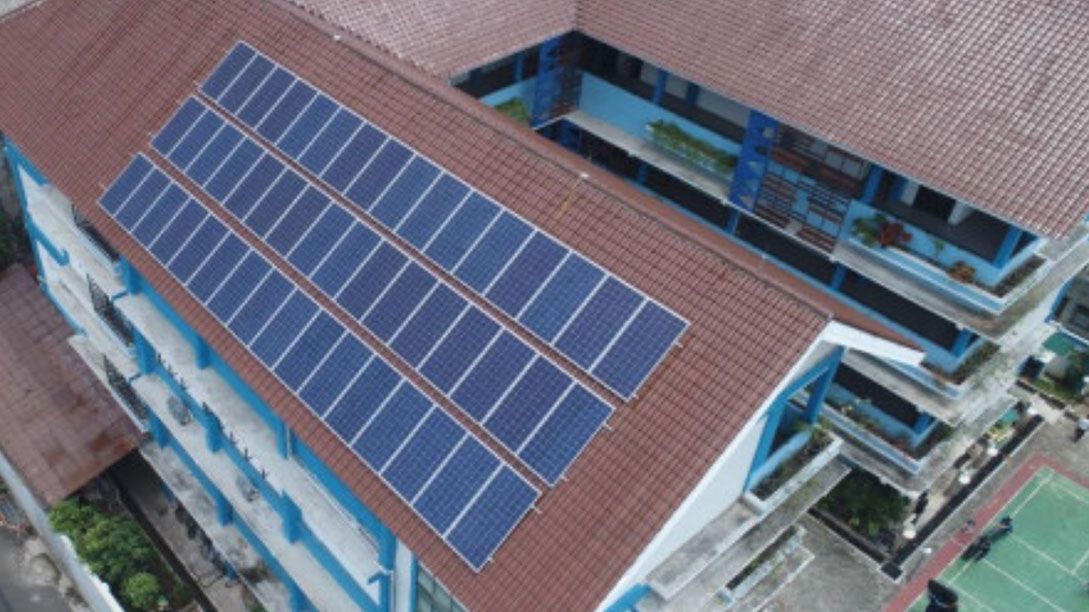
S8.6 kWp grid-tied solar power system at a school in Jakarta, East Jakarta. For business owners, using solar power s also good from a marketing perspective because it will attract environmentally conscious customers.
Types of solar energy systems
There are three main systems of solar power: on-grid or grid-tied solar system, off-grid solar system, and hybrid solar system. Let’s find out what they mean, and which one suits you best for your Lombok property.
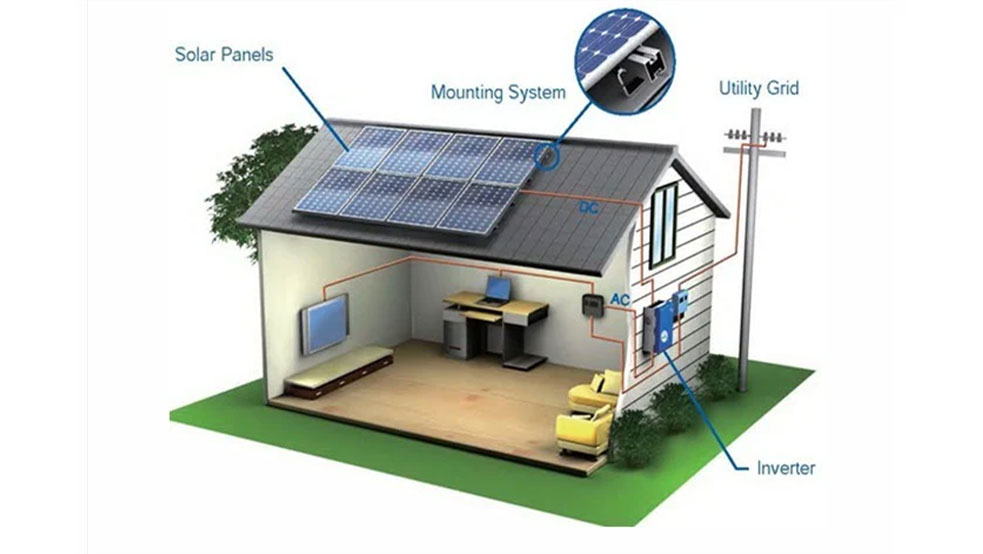
1. On-grid solar system
Simply put, this means that your electrical system will stay connected to the PLN grid, and will need to be registered with PLN for net metering. However, your surplus electricity cannot be fed back into the grid anymore, by law. Only install a system to cover daytime needs, or add batteries to store surplus energy.
This is the most affordable and popular option among home and business owners in Lombok.
When your solar panels do not generate enough electricity to meet your demands, your appliances will automatically draw energy from PLN
GOOD FOR:
Most households and places of business in areas with reliable PLN, such as South lombok
PROS:
The most affordable way to use solar energy Excellent payback of 4-6 years and ROI of over >800%
CONS:
Can not be used during power outages
2. Off-grid solar system
As the name suggests, this system means that your solar panels and system are disconnected from the PLN grid. It is a great solution for areas where PLN is not available.
By using an off-grid solar system with lithium batteries, you can move away from using noisy fuel-based generators that require plenty of maintenance and are costly to operate.
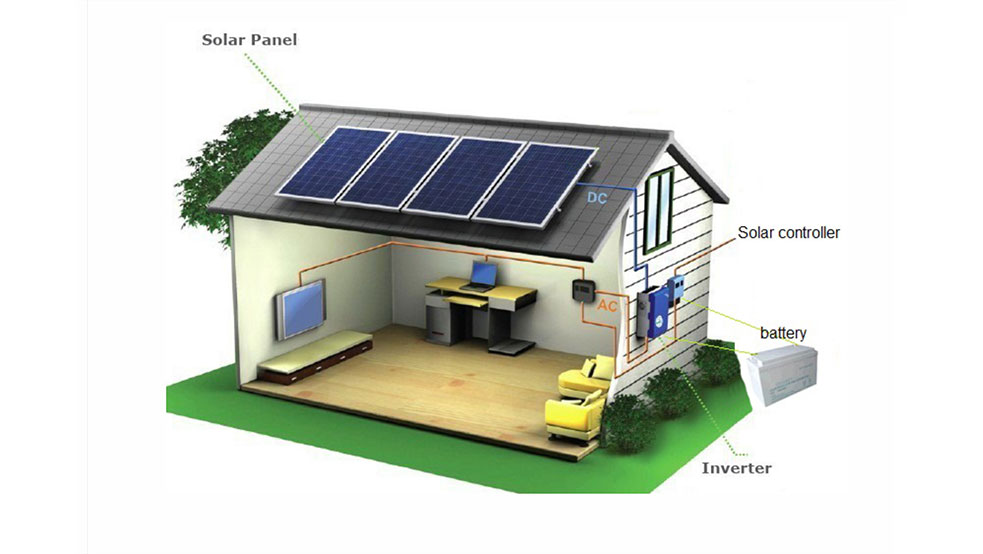
This system can indeed be quite costly. However, you can reduce the initial investment cost by pairing it with a small conventional generator that will only run during the worst-case scenario with no sunshine for days, which usually happens only a few days per year.
GOOD FOR:
Remote areas with no PLN, or extremely unstable electricity supply. As PLN is rather reliable in lombok and pretty much available everywhere in both Bali and Lombok we don’t recommend it for these areas, but would rather recommend going with a hybrid solar system that provides backup during power outages only.
PROS:
No maintenance, unlike generators and lead-acid batteries Save on generator fuel cost Clean, green, and not noisy compared to generators Smart monitoring system to preserve battery lifetime Cheaper per kWh than generators
CONS:
Requires a large system to provide energy when there is no sunshine for several days- but this can be solved by adding a generator for the worst-case scenario Requires a considerable upfront cost Shall you decide to go for an off-grid system, we can help design the most optimized and efficient system to meet your demands without breaking the bank. Contact us.
3. Hybrid solar system
This is the system that we highly recommend to anticipate for power outages in Bali, Lombok, and pretty much anywhere else in Indonesia.
Since you are still connected to the grid, you will benefit from net metering which allows you to save on your electricity bill, just like with an on-grid system. However note that you may not export surplus to the grid, the surplus is fed into your batteries
Similar to an off-grid solar panel system, pairing solar panels with storage batteries will allow you to move away from conventional generators or lead-acid batteries.
The longer lifetime of lithium batteries and the fact that it doesn’t require any maintenance cost also makes it an excellent choice from a financial standpoint.
Contact us to have a cost-efficient hybrid solar system designed specifically for you.
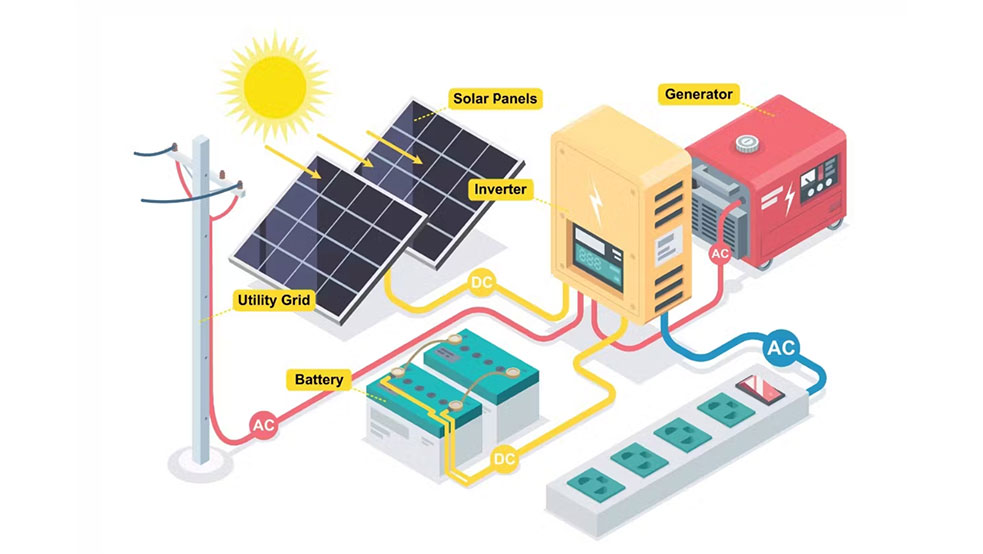
Choosing solar panels & designing your system
Of course, you can just contact us to design the best solar panel system for you in Bali, Lombok, or wherever you are in Indonesia. However, in case you’re wondering, these are the things that you need to keep in mind for coming up with the best system:
1. Determining the size or capacity of your solar panel system We can determine the most optimal solar system s ize with these key considerations:
PLN capacity. If you’re connected to the grid, you are required by law to install no more solar system kWp than y our current PLN capacity.
Electricity bill. We can also determine the size of the solar system you actually need by looking at your monthly electricity bill and dividing it by the latest PLN tariff per kWh
Space. Of course, the number of panels we can install could be limited by the space you have. Consider that shaded areas (under trees, shaded by large cables or other buildings) and steep pitched roofs are not ideal. The best orientation is north-facing at a 10-30 degree pitch.
Batteries. Shall you decide to add batteries to your system, we will need to make sure that your solar system’s size is sufficient to charge your batteries also.
2. Choosing the right solar panel type
There are two main types of solar panels: monocrystalline and polycrystalline. Without going too much into details, monocrystalline panels offer higher efficiency rates and are more uniform in appearance as opposed to polycrystalline panels.
Higher efficiency means that they produce more power per square meter than their polycrystalline counterparts. Monocrystalline panels also perform better and offer a longer lifetime.
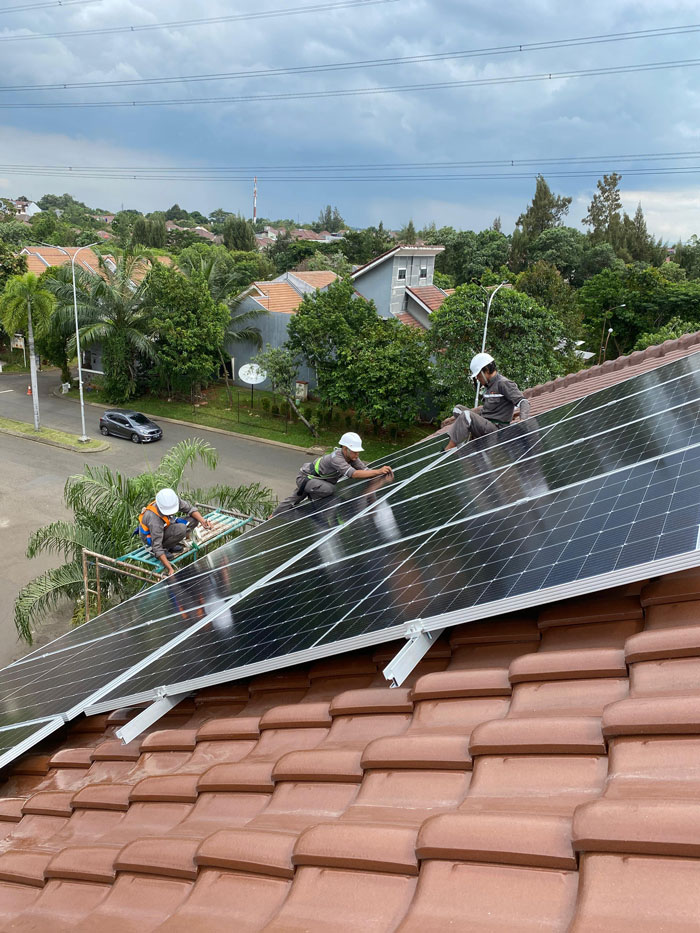
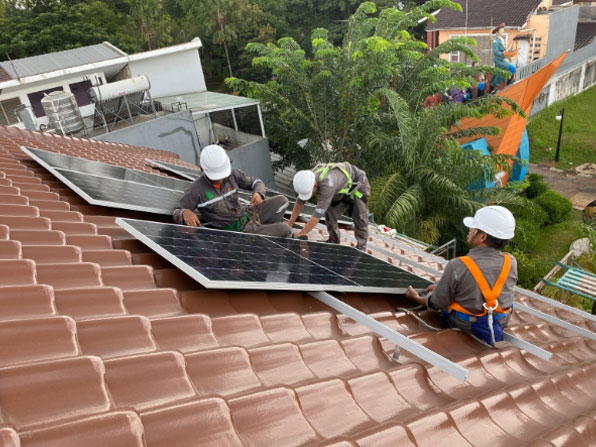
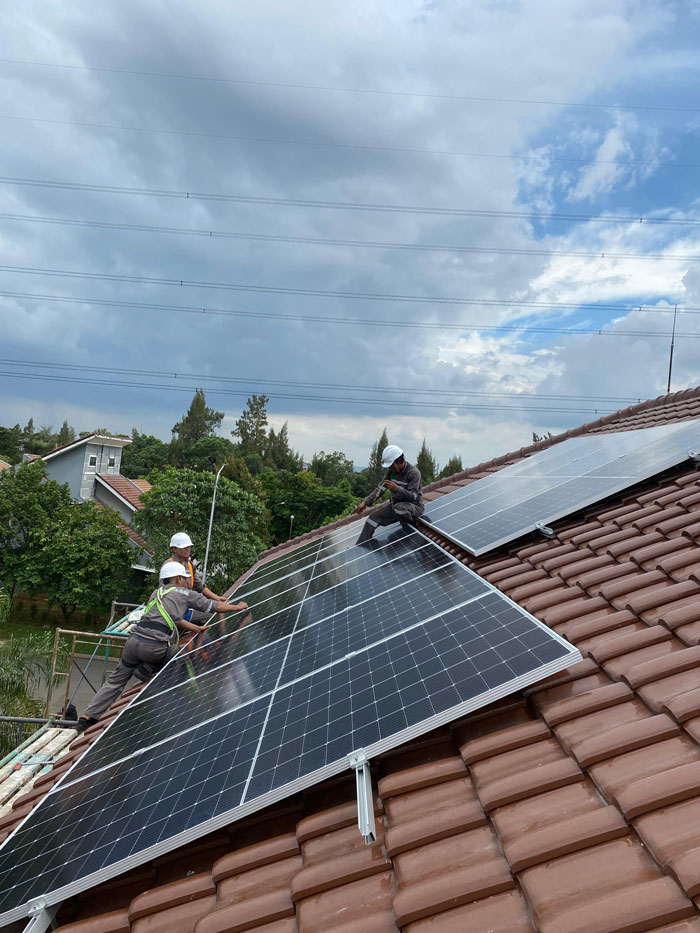
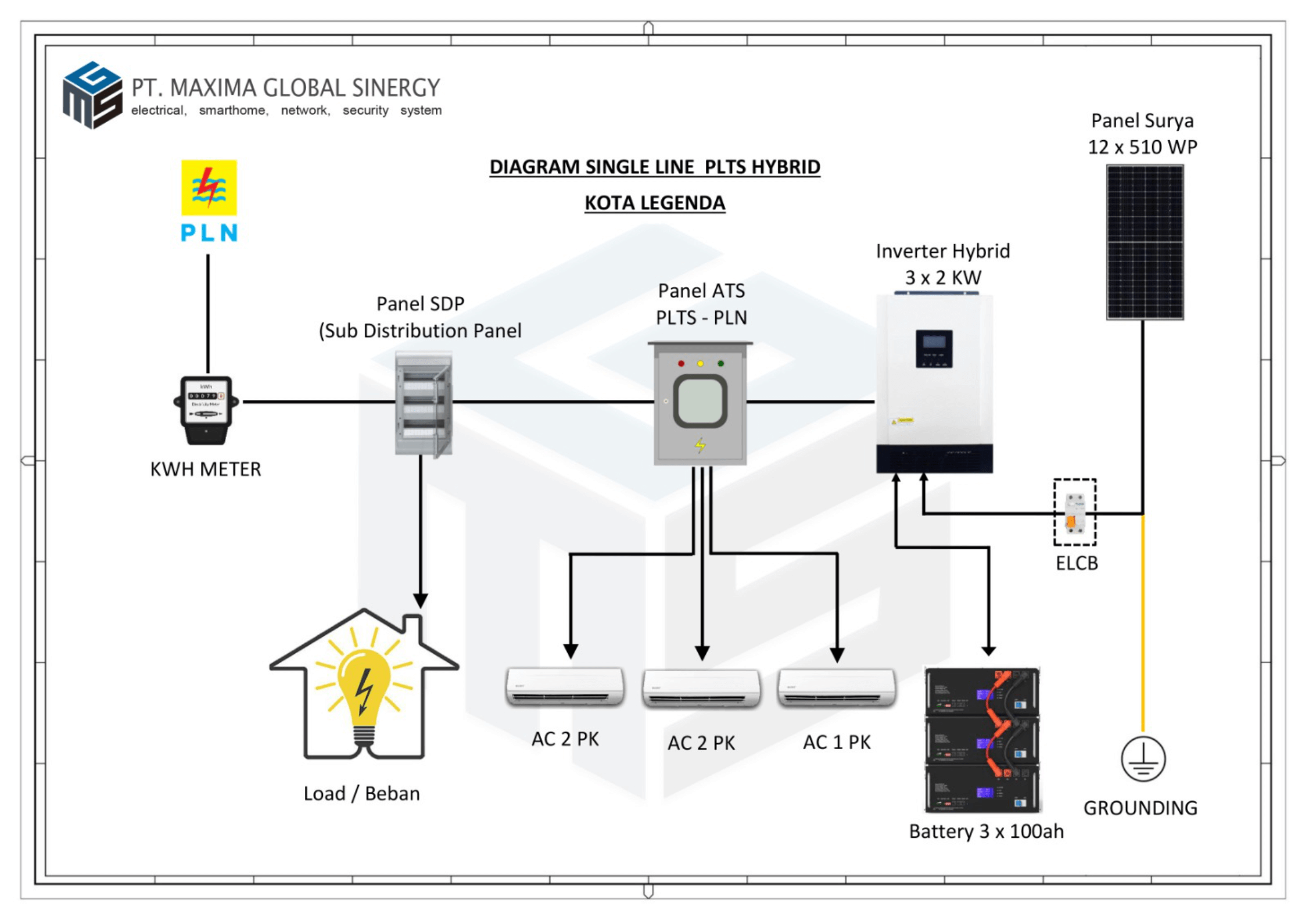
Installed Power: 16,500 VA
AC Load Requirements Using Solar Power System (PLTS):
- 1 unit of 1 HP AC: 1,000 watts
- 2 units of 2 HP AC: 2,000 x 2 = 4,000 watts
Total Load: 5,000 watts
PLTS Capacity:
510 Wp x 12 panels = 6,120 watts
The energy generated from solar power is 6,120 watts, while the AC load is 5,000 watts.6,120-5,000 = 1,120 watts
The excess energy of 1,120 watts generated during peak sunlight hours can be used to help charge the battery.
Battery:
51 V x 100 Ah = 5,100 watt-hours (Wh) per unit 5,100 Wh x 3 units = 15,300 Wh
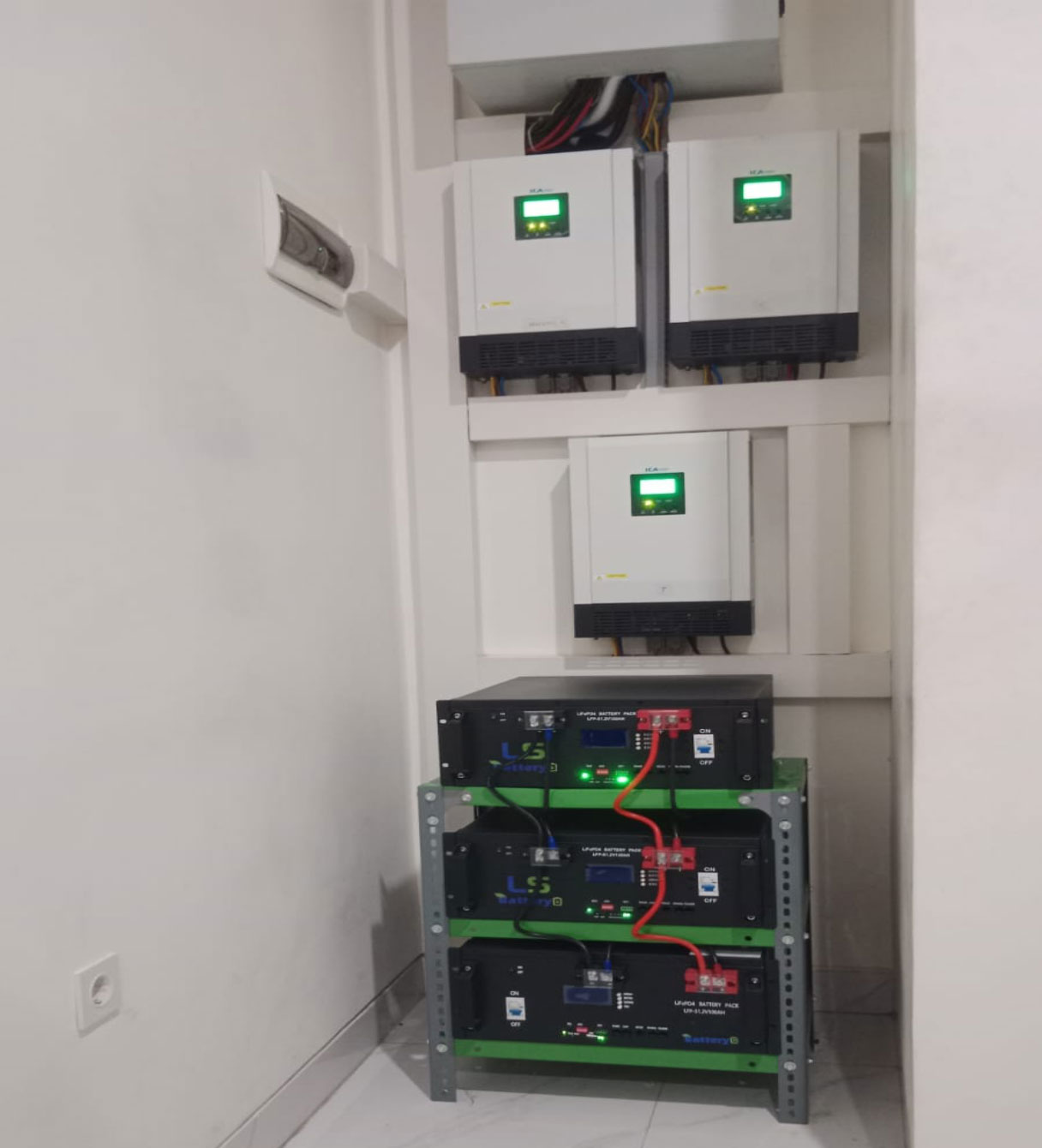
With a total battery capacity of 15,300 Wh, the system can support the AC load at night for approximately 3 hours. After the batteries are depleted, the load will be automatically covered by the grid (PLN).
Solar power array placement
Rooftop solar panels are the most common for most buildings in Bali and Lombok. You can place your solar array pretty much on any type of roof, except for certain types of roofs such as thatched alang alang roofs.
hat aside, in order to get the most optimal output from your solar panels, here are the things that you need to keep in mind:
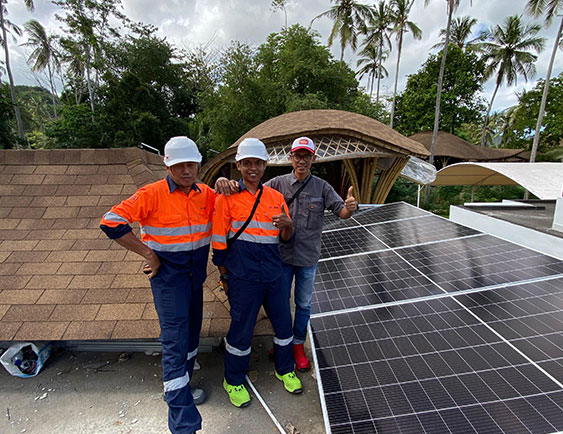
ROOF ORIENTATION
As Bali and Lombok are located in the Southern Hemisphere, the best orientation for your solar array would be north-facing. West and eastward placement are indeed possible as long as your roof area gets enough direct sunlight exposure. Any roof that is south-facing is not as ideal but it is still possible to put your array there.
ROOF PITCH
The most ideal roof pitch for solar panel installation in Bali and Lombok would be anywhere between 10-30 degrees. Flat roofs are also great because it’s easy to create a pitched aluminum structure to support your panels.
It is possible to install your solar array on a steeper roof but your solar panels’ output will slightly decrease.
ROOF SIZE
Our standard 450-watt solar panels are about 2 sqm equalling 4.5 sqm for every kilowatt installed. Needless to say, the number of panels we can install will depend on the size of your roof.
ROOF STRENGTH & MATERIAL
This is typically not an issue as solar panels are quite light-only 12kg/sqm in our case-but it never hurts to make sure that your roof structure is strong enough and the roof material is suitable for solar panels.
For instance, thatched alang-alang roofs, which are quite common in Bali and Lombok are not suitable.
ACCESS
The easier it is to access your array, the better. To keep your solar array working at its best, your panels will need to be cleaned regularly to keep them free of dust, debris, leaves, and so on.
ALTERNATIVE PLACEMENT
What if your roof is unsuitable for solar power? We can remedy this by building a shed-type structure on your carport or somewhere in your garden. Ground-mounting is another possible solution provided that you have enough open space for a ground-mounted array.
Battery or no battery?
As mentioned in Part III: Types of Solar Systems, grid-tied solar systems do not necessarily require a battery.
In most of Bali, PLN has been quite stable and power outages do not happen very often. However, if you plan to have a power backup generator at your building, you could consider switching to a lithium battery system.
Lithium batteries have a very long lifetime-6,000 cycles in our case, equalling more than 16 years even if discharged every day.
They also require no maintenance, generate no noise, and of course, you get to move away from using fossil fuels and reduce your CO2 emissions.
As for Lombok, we always recommend adding batteries for private and commercial buildings alike, as power outages happen very often and for hours at a time.
If you want to have a backup battery system, we can help you design the most efficient and optimized hybrid solar system for your needs.

Solar panel prices & return on investment (ROI)
On to the million-dollar questions: how much should you expect to pay for a solar system, and is it worth it?
How much does a solar panel system cost in Bali and Lombok?
For a standard rooftop solar system installation in Bali, you can expect around IDR 10-30 million (+/- USD 650-1,300) per kWp (kilowatt peak) installed.
This price typically includes solar panels, inverter, and everything else you need to get a working on-grid solar system installation.
Additional costs that may occur include:
PLN net metering application. This is mandatory if you are connected to the PLN grid and costs on average IDR 2-8 million.
Batteries, shall you decide to add them to your system
Additional logistics costs, depending on where you are located. Extra costs may incur if you are located outside major cities
Additional installation costs, in case your system requires additional reinforcements, extra cabling, and so on.
Solar power financial benefits & ROI in Bali & Lombok
Bali and Lombok are blessed with abundant sunshine year-round, hence the break-even period and return on investment for a solar system are very attractive.
Let’s take a look at some examples* from our past clients:
Please note that the following financial simulations assume 100% self-consumption of the produced solar power and a consistent increase of electricity price throughout the system’s lifetime.
EXAMPLE ONE Mr. X in Lombok
| Solar Capacity | 12.80 kWp |
| Battery Storage Capacity | NA kWh |
| Output / Day | 55.3 kWh |
| Output / Year | 20,182 kWh |
| Area Required | 64 sqm |
| Payback Achieved | Year 5 |
| Return on Investment | 1039% |
| CO₂ Emissions Saved (per year) | 12,109 kg/y |
| CO₂ Saving Over Lifetime | 302,730 kg |
Solar power installation process
Ready to embark on your solar journey? Here are the next steps:
1. Getting a quote
When requesting a quote, you will typically need to provide the following information:
Exact location• Photos or drawings of your roof, including roof orientation, pitch, and measurements
• Current PLN size and system (1 or 3 phase)
• Desired solar system size in kWp (kilowatt peak)
• Whether you would like batteries or not
